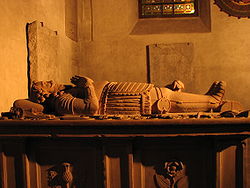.gif)
Samuel Cockburn (mercenary leader)
Encyclopedia

Scottish people
The Scottish people , or Scots, are a nation and ethnic group native to Scotland. Historically they emerged from an amalgamation of the Picts and Gaels, incorporating neighbouring Britons to the south as well as invading Germanic peoples such as the Anglo-Saxons and the Norse.In modern use,...
mercenary
Mercenary
A mercenary, is a person who takes part in an armed conflict based on the promise of material compensation rather than having a direct interest in, or a legal obligation to, the conflict itself. A non-conscript professional member of a regular army is not considered to be a mercenary although he...
leader in the service of Sweden
Sweden
Sweden , officially the Kingdom of Sweden , is a Nordic country on the Scandinavian Peninsula in Northern Europe. Sweden borders with Norway and Finland and is connected to Denmark by a bridge-tunnel across the Öresund....
. He was born around 1574 in Scotland
Scotland
Scotland is a country that is part of the United Kingdom. Occupying the northern third of the island of Great Britain, it shares a border with England to the south and is bounded by the North Sea to the east, the Atlantic Ocean to the north and west, and the North Channel and Irish Sea to the...
and died in December 1621 during a military campaign in Latvia
Latvia
Latvia , officially the Republic of Latvia , is a country in the Baltic region of Northern Europe. It is bordered to the north by Estonia , to the south by Lithuania , to the east by the Russian Federation , to the southeast by Belarus and shares maritime borders to the west with Sweden...
. He was buried in 1622 in Turku cathedral.
Cockburn participated in Karl IX's and Gustav II Adolf's war
Ingrian War
The Ingrian War between Sweden and Russia, which lasted between 1610 and 1617 and can be seen as part of Russia's Time of Troubles, is mainly remembered for the attempt to put a Swedish duke on the Russian throne...
in Russia
Russia
Russia or , officially known as both Russia and the Russian Federation , is a country in northern Eurasia. It is a federal semi-presidential republic, comprising 83 federal subjects...
and in the Baltic states
Baltic states
The term Baltic states refers to the Baltic territories which gained independence from the Russian Empire in the wake of World War I: primarily the contiguous trio of Estonia, Latvia, Lithuania ; Finland also fell within the scope of the term after initially gaining independence in the 1920s.The...
, advancing to the rank of colonel
Colonel
Colonel , abbreviated Col or COL, is a military rank of a senior commissioned officer. It or a corresponding rank exists in most armies and in many air forces; the naval equivalent rank is generally "Captain". It is also used in some police forces and other paramilitary rank structures...
. He was best known for his leadership of Finnish troops, notably in the capture of Novgorod on July 16, 1611. During one of these campaigns he built the fort Cobrun's mound outside Riga
Riga
Riga is the capital and largest city of Latvia. With 702,891 inhabitants Riga is the largest city of the Baltic states, one of the largest cities in Northern Europe and home to more than one third of Latvia's population. The city is an important seaport and a major industrial, commercial,...
, which is bordered on the southern side by the river Düna
Duna
Duna is the Soviet-Russian pop-music band that was created in 1987. It became very popular in 1989 just before the fall of the Soviet Union with the song .-Members:*Viktor "Ryba" Rybin, vocal, percussion...
. The fort saw much use during the period of the Swedish Golden Age
Rise of Sweden as a Great Power
During the 17th century, despite having scarcely more than 1 million inhabitants, Sweden emerged to have greater foreign influence, after winning wars against Denmark–Norway, The Holy Roman Empire, Russia, and The Commonwealth of Poland and Lithuania...
. Some sources mention a certain Daniel Cobron as the founder, but this likely the result of a spelling error.) For his service the king awarded Cockburn 301 farms in western Finland
Finland
Finland , officially the Republic of Finland, is a Nordic country situated in the Fennoscandian region of Northern Europe. It is bordered by Sweden in the west, Norway in the north and Russia in the east, while Estonia lies to its south across the Gulf of Finland.Around 5.4 million people reside...
.
External links
- Scots in Sweden, by Jonas Berg and Bo Lagercrantz, Seventeenth Century.
- Riga in the 17th century, by Douglas MacKenzie (1994).
- Living history in English, based on Adolf Lindman's Muistiinpanoja Turun tuomiokirkosta (Helsinki 1890), but the death date and place are probably incorrect
- Biography (in Finnish) of Samuel Cobron (1574-1621).
- Samuel Cobron's role in the Ingrian War, 1610-1617.

